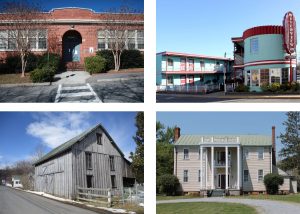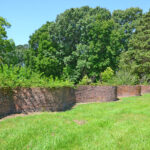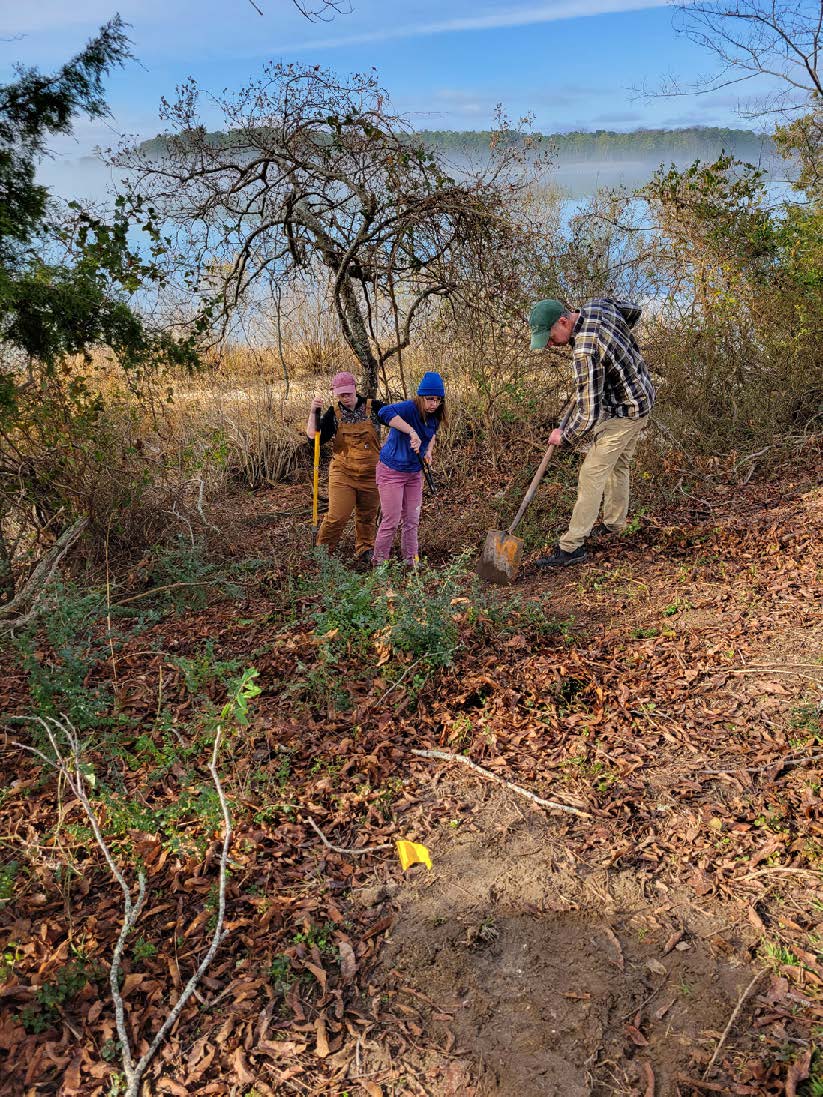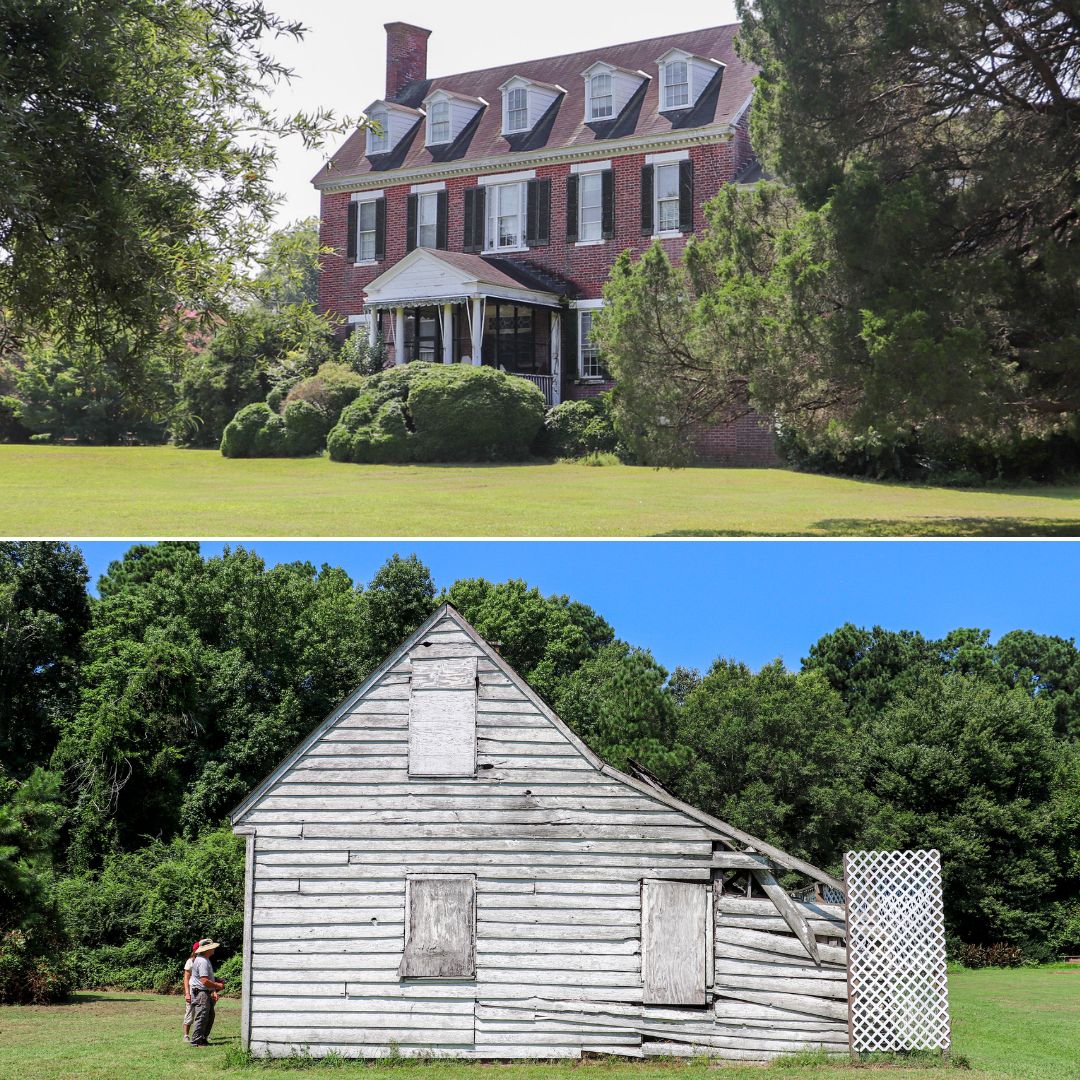Nine Historic Sites Added to the Virginia Landmarks Register, June 2021
 —VLR listings are in the counties of Bedford (2), Brunswick, Campbell, Loudoun, Pulaski, Rockbridge, Warren, and Westmoreland—
—VLR listings are in the counties of Bedford (2), Brunswick, Campbell, Loudoun, Pulaski, Rockbridge, Warren, and Westmoreland—
Among nine places listed on the Virginia Landmarks Register are a historic district on the Northern Neck that encompasses a late-1800s resort, a house in Southside associated with a circuit-riding preacher who helped spread Methodism in Virginia, an 18th-century house once proffered to Thomas Jefferson, and three 20th-century schools.
The commonwealth’s Board of Historic Resources approved the Virginia Landmarks Register (VLR) listings during its quarterly public meeting that the Department of Historic Resources hosted and convened virtually. The VLR is the Virginia's official list of places of historic, architectural, archaeological, and cultural significance.
The Colonial Beach Commercial Historic District in Westmoreland County captures the business center of a fully planned resort along the lower Potomac River. Platted in 1882, the Northern Neck resort was conceived as a riverside playground for visitors from Washington D.C. Colonial Beach’s origins distinguishes it from other Chesapeake Bay region resorts of the era, which developed piecemeal. The town plan provided for a prominent site incorporating a low rise near the Potomac River reserved for a hotel, as well as river- and bay-side drives, parks, and main streets reaching the beach area from a main county road.
The district’s diverse collection of 81 contributing buildings represents the whole of its nearly century-long period of significance—circa 1875 to 1970—and reflects major trends in waterside resort community development and architecture from the late 1800s through the 20th century. [See more information.]
In Southside’s Brunswick County, the Dromgoole House, built between 1796 and 1799, was the plantation home of Reverend Edward Dromgoole. One of America’s early traveling ministers and a friend of Bishop Francis Asbury, Rev. Dromgoole helped spread John Wesley’s Methodist movement in America, boosting the rapid rise of the Methodist Episcopal Church in the 18th and early 19th century. After Rev. Dromgoole’s death in 1835, his son, George Coke Dromgoole, resided at the property until 1847. He represented his region of Virginia in the state legislature for 13 years, then in Congress for seven years.
The Dromgoole House, a two-story, mortise-and-tenon timber frame dwelling, embodies Federal period vernacular style. The property also features a Spring House–Workhouse dating to at least 1803 and a family cemetery. In 2020, the United Methodist Church designated the property a United States Methodist Historic Site, the only extant home within the conference that once belonged to an 18th-century circuit rider and where Methodist class meetings and worship services occurred. [See more information.]
The Grove is a substantial, evolved Federal-style house located about nine miles southwest of Lynchburg in Campbell County, where few documented 18th-century dwellings survive. The first known reference to the property survives in an 1802 letter to Thomas Jefferson from owner James Richardson Penn, who offered to sell the property to Jefferson. Jefferson declined the offer but soon began construction of Poplar Forest, his Bedford County retreat, near The Grove.
The house preserves late-18th- to early-19th-century construction materials and methods in both its main block and 1803 rear ell. It features mortise-and-tenon framing with hewn timbers and rose-head nails, and impressive Flemish-bond chimneys. The house interior exhibits fine artisanship in Federal-style finishes such as its decorative wainscoting, fireplace mantels, heart pine flooring, windows, doors, and molded trim. [See more information.]
Of the three schools listed to the VLR, two in Bedford County were constructed for African American students during the era of public school segregation in Virginia. Both schools were affiliated with broad efforts across numerous Virginia jurisdictions to avoid school integration by offering Blacks improved educational facilities that would ostensibly comply with the "separate but equal" rationale on which segregation was based.
Bedford Training School, built during 1929-1930, was the county’s first public school to provide secondary education for African American students. Virginia’s Department of Education provided architectural plans for the school, which the county expanded in 1939-1940 to house additional classrooms in a two-story rear addition. With renovations, Bedford Training School became a consolidated elementary school for Black students in 1954, part of the county’s attempt at separate but equal public education.
The Colonial Revival style, well-preserved brick school building illustrates the preference in Virginia for a traditional style for educational buildings during the first half of the 20th century. In 1970, the county fully integrated the school, and later repurposed the building for the Bedford County School Board offices. [See more information.]
Susie G. Gibson High School, constructed between 1953 and 1954 under the separate but equal impetus, was the county’s sole high school for Black students and a culmination of the Black community’s campaign to secure high school education for its children. Located on a hilltop campus in the Town of Bedford, it was named for former teacher and activist Susie G. Gibson, the county’s supervisor of African American education for 22 years before her death in 1949.
Designed in the International Style by Lynchburg-based architect Stanhope S. Johnson, the exceptionally well-preserved school building embodies Modern Movement design with its functional, human-scale, strictly rectilinear buildings and lack of extraneous ornamentation. In 1966, the county added a large auditorium and additional classrooms. Since the integration of Bedford County schools in 1970, the county has repurposed Susie G. Gibson High School for multiple educational uses. [See more information.]
In Pulaski County, the two-story brick Claremont Elementary School was constructed in 1952, with additions in 1953, to alleviate overcrowding in its elementary schools in conjunction with the county Board of Education’s 1950s campus improvement campaign. Exemplifying the Virginia Department of Education’s initiative to support mid-20th century progressive trends and supply students with spacious, well-ventilated, and amply lit instructional areas, the school is one of the county’s most intact 1950s educational buildings.
Designed by the Roanoke-based firm Smithey and Boynton, the building’s Modernist characteristics include a flat-roofed, angular form, horizontal massing, and tall, steel-frame, multi-pane windows. The 8.29-acre campus served Pulaski’s elementary-grade students and gave residents a community center until 2004. It currently retains the look and feel of its original setting, although renovations undertaken around 2007 temporarily diminished the building’s character. [See more information.]
The Virginia Board of Historic Resources also approved three other VLR listings during its quarterly meeting:
- The nearly 75-acre Browntown Historic District encompasses most of a village located in a valley in the Blue Ridge Mountains of southern Warren County. Browntown coalesced around the Brown–Updike Mill during the early-to-mid 1800s. The picturesque settlement took its present crossroads form after the 1874 opening of Cover Tannery, propelling its growth, which followed in the early 1900s with the establishment of stave and tool-handle factories that sustained the village economy. The historic district encompasses 80 contributing buildings, mostly houses, as well as churches, stores, barns, a schoolhouse, railroad depot, and archaeological sites. [See more information.]
- Completed in 1859, the Bernard Hough House is a Greek Revival–style residence in Loudoun County near the village of Hillsboro. The house is noteworthy for its brick construction, a rarity in a region dominated by the era’s stone, log, and frame buildings. Largely unaltered since its construction, Hough House’s distinguishing architectural elements include a five-bay frame porch and double-front doors, molded cornices, a balustrade central deck atop the main hip roof, and a rear ell with a gable-end chimney. The interior retains its architectural integrity, with elaborate woodwork, molding, fireplaces, and other details still intact. The property also features a cottage originally constructed to house enslaved workers, and a mid-19th century barn. A Hillsboro religious community leases the barn and fields, plus an additional portion of Hough’s original 169-acre farm, to grow produce it sells within the nearby Hillsboro Historic District, making the property, now known as Shannondale Farm, one of the last operating farms on Hillboro’s south side. [See more information.]
- The Taylor-Kinnear Farm in Rockbridge County centers on a well-preserved two-story brick house detailed in the Federal style and built for David Taylor Sr. in about 1820. Acquired in 1849 by John A. Kinnear, whose descendants owned the property into the 21st century, the house expanded several times in the late 1800s and early 1900s and has many noteworthy architectural features, including Federal-influenced fireplace mantels, extensive faux graining, unusual stamped decorative painting, and a wraparound one-story porch. An addition built around the turn of the 20th century reoriented the house toward the road, giving it two facades. The property also has a timber-framed barn and an unusually large granary building dating to the early 20th century. [See more information.]
The Department of Historic Resources will forward the documentation for these newly listed VLR sites to the National Park Service for nomination to the National Register of Historic Places.
Listing a property in the state or national registers is honorary and sets no restrictions on what property owners may do with their property. The designation is foremost an invitation to learn about and experience authentic and significant places in Virginia’s history.
Designating a property to the state or national registers—either individually or as a contributing building in a historic district—provides an owner the opportunity to pursue historic rehabilitation tax credit improvements to the building. Tax credit projects must comply with the Secretary of Interior’s Standards for Rehabilitation.
Virginia is a national leader among states in listing historic sites and districts on the National Register of Historic Places. The state is also a national leader for the number of federal tax credit rehabilitation projects proposed or completed each year.












